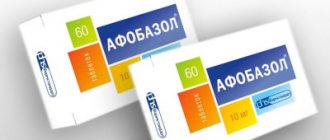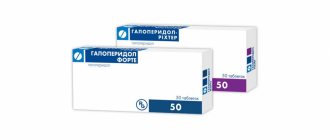Pharmacological properties of the drug Betaserc
Pharmacodynamics. The mechanism of action of betahistine is not fully understood. It increases blood circulation in the stria vascularis of the inner ear, by relaxing the precapillary sphincters in the microcirculation system of the inner ear. It has been established that betahistine has a weak agonistic effect on H1 receptors and a pronounced antagonistic effect on histamine H3 receptors in the central and autonomic nervous system. In addition, it was found that betahistine has a dose-dependent inhibitory effect on the generation of peak potentials in neurons of the lateral and medial vestibular nuclei. Betahistine accelerates the process of restoration of vestibular function after unilateral neurectomy, accelerating and facilitating the process of central vestibular compensation. This effect is characterized by increased regulation of histamine metabolism and release and is realized as a result of H3 receptor antagonism. In combination, all these properties provide a positive therapeutic effect of betahistine in the treatment of Meniere's disease and vestibular vertigo of various origins. Betahistine enhances the metabolism and release of histamine by blocking presynaptic H3 receptors, which leads to a decrease in their sensitivity. This effect on the histaminergic system explains the effectiveness of betahistine in the treatment of dizziness and vestibular disorders. Pharmacokinetics. After oral administration, betahistine is quickly and completely absorbed from the gastrointestinal tract. It is quickly and completely metabolized to form 2-pyridylacetic acid (a pharmacologically inactive metabolite). The concentration of betahistine in the blood plasma is low (below the detection limit ≤100pg/ml). In this regard, pharmacokinetic analyzes are carried out by measuring the metabolite 2-pyridylacetic acid in plasma and urine. The maximum concentration of the metabolite in the blood plasma is achieved 1 hour after administration. The half-life of 2-pyridylacetic acid is approximately 3.5 hours. 2-pyridylacetic acid is rapidly excreted from the body in the urine. When taking the drug in a dosage of 8-48 mg, about 85% of the initial dose is determined in the urine. Excretion of betahistine by the kidneys or feces is insignificant.
Experience of using Betaserc in angioneurology
The main causes of ischemic changes in the vertebrobasilar system are factors that limit the flow of blood into this system or promote excessive outflow from it to other vascular beds. The role of hemorheological changes is also undoubted. The diagnosis of circulatory failure in the vertebrobasilar system is based on a characteristic symptom complex that combines several groups of clinical symptoms usually found in patients with atherosclerosis, arterial hypertension and various extravasal pathologies. These include visual and oculomotor disorders; violations of statics and coordination of movements; vestibular disorders. It is this symptom complex that occurs in more than 80% of patients with circulatory failure in the vertebrobasilar system [1]. In the pathogenesis of vestibular disorders in VBI, the leading role is played by damage to the vestibular nuclei of the brain stem or vestibulocerebellar connections, but peripheral cochleovestibular syndrome caused by ischemia of the structures of the inner ear is also of certain importance. Treatment of vestibular disorders is a pressing problem, especially considering the frequency of their occurrence and the impact on the quality of life of patients. Drug therapy includes taking both drugs that optimize cerebral circulation and specific agents that act primarily on the structures of the vestibular analyzer. An effective treatment for vestibular disorders is betahistine hydrochloride (Betaserc, Solvay Pharma). Over the past 20 years, a large number of studies have been carried out to evaluate the effectiveness of the drug, including a number of double-blind studies. Currently, Betaserc is a clinically proven effective drug for the treatment of Meniere's disease and other vestibular disorders caused by damage to the peripheral part of the vestibular analyzer. At the same time, there are insufficient studies of the effectiveness of Betaserc in vascular pathology of the brain accompanied by central vestibular syndrome (CVS). The purpose of this work was to study the effectiveness of Betaserc in relation to vestibular disorders in VBI. The objectives of the study were: 1. To study the effectiveness of Betaserc in patients with vertebrobasilar insufficiency. 2. Comparative analysis of the effectiveness of using Betaserc in the central and peripheral levels of damage to the vestibular analyzer. General characteristics of patients and research methods 105 patients with VBI were examined (64 women and 41 men, average age 59 years, range from 31 to 79 years). As a control group, 29 patients with Meniere's disease were examined (19 women and 10 men, average age 52 years, range from 22 to 64 years). In addition to general clinical and neurological examinations, all patients underwent: CT or MRI studies of the brain, Doppler ultrasound, as well as duplex scanning of the main arteries of the head, and a study of acoustic brainstem evoked potentials. Otoneurological examination was carried out according to the generally accepted classical method of N.S. Blagoveshchenskaya. All patients were examined otoneurologically twice – at the beginning and at the end of the course of taking Betaserc. All patients in the main and control groups received a standard course of treatment with Betaserc lasting 60 days (48 mg of the drug daily) without any change in basic therapy (hypotensive, vascular, neurometabolic). The effectiveness of Betaserc was assessed based on the analysis of subjective data (patient complaints of dizziness, imbalance, oscillopsia) and the results of an otoneurological examination. Results and discussion The clinical picture of vestibular disorders in patients with VBI was most often represented by periodic systemic dizziness lasting several seconds, minutes or hours. Attacks of dizziness occurred spontaneously or were associated with changes in the position of the head or body (turning and throwing back the head, bending the torso). Dizziness was often accompanied by nausea and vomiting, falling, and loss of consciousness. Sometimes it was combined with auditory symptoms: noise in the ears or head, ear congestion, hearing loss. The frequency of dizziness attacks varied - from almost daily short-term episodes to rare attacks, 1-2 times a year. During the interictal period, most patients noted imbalance, coordination of movements, “visual” dizziness (symptom of “wavering shadow”), and oscillopsia. During otoneurological examination, PCV was detected in all patients with VBI. In 26 patients (25%), in addition to the central one, peripheral vestibular syndrome (PVS) was also determined. In the control group, PVS was present in 100% of patients. After a course of treatment with Betaserc, 102 (97.1%) patients showed a decrease in the severity of subjective complaints and an improvement in objective indicators. In the control group, the same figure was 96.5%. The effectiveness of Betaserc in relation to vestibular disorders in VBN and Meniere's b-ni is shown in Table 1. There were no statistically significant differences between the results in the main and control groups. To exclude the possibility of interpreting the positive effect of Betaserc in patients with VBN only due to the effect on the peripheral part of the vestibular analyzer, we conducted a comparative analysis of the effectiveness of Betaserc in patients with only CVS compared with those with mixed symptoms: central and peripheral vestibular syndromes. The results of the study are presented in Table 2. There were also no statistically significant differences between the groups. Thus, our study showed that Betaserc is an effective drug for relieving vestibular disorders not only at the peripheral level, but also at the central level. And it can be successfully used in angioneurology, in particular for VBI. The histaminergic system plays an important role in the functioning of the vestibular structures. Thus, the transmission of impulses from vestibular receptors and vestibular nuclei is provided primarily by histaminergic neurons. A number of studies have shown that the effectiveness of Betaserc is associated with a decrease in both spontaneous and evoked impulses from vestibular receptors and vestibular nuclei. Thus, in the experiment it was found that Betaserc reduced the intensity and amplitude of impulses of neurons of the lateral vestibular nucleus both at rest and during stimulation. Along with the effect on histamine receptors of peripheral and central vestibular formations, Betaserc has a vasoactive effect. The drug causes dilation of the arterioles and capillaries of the inner ear, which leads to a selective increase in blood flow. In addition, while taking the drug, there is a slight increase in cerebral blood flow, both in the vertebrobasilar and carotid systems. The vasoactive effect of Betaserc is presumably due to blocking histamine H3 receptors and, possibly, an effect on presynaptic adrenergic receptors. Analysis of the effect of the drug Betaserc indicates its versatile influence on various pathogenetic mechanisms of dizziness and, consequently, the pathogenetic validity of the use of the drug. Betaserc does not cause significant side effects. In rare cases, mild dyspeptic symptoms, allergic skin reactions and headaches occur. No side effects were observed in our patients.
Literature 1. Vereshchagin N.V. Circulatory insufficiency in the vertebrobasilar system. Consilium medicum. 2001. Appendix. P. 13. 2. Lavrov A.Yu. Application of Betaserc in neurological practice. Neurological Journal, 2001. No. 2. v. 6. P. 10.
Use of the drug Betaserc
The daily dose for adults is 24–48 mg, evenly distributed throughout the day.
8 mg tablets | Tablets 16 mg | Tablets 24 mg |
| 1-2 tablets 3 times a day | 1 tablet 3 times a day | 1 tablet 2 times a day |
It is advisable to take the tablets after meals. The dose is selected individually depending on the effect. A decrease in symptoms is sometimes observed only after 2-3 weeks of treatment. The best results are achieved when taking the drug for several months. There is evidence that treatment early in the disease prevents progression and/or hearing loss in later stages.
A little about original drugs
But first, we need a little insight into the question of what is the original drug. The original medicine is called the medicine of the company that invented the formula of the active substance. It should be noted that several years pass before entering the market. The substance undergoes multi-stage testing: theoretical, on animals, after proven safety, clinical trials on humans are carried out. At the same time, the rules governing the entry of funds into the market are very strict.
What happens next? The drug is launched on the market. Moreover, only the manufacturer has a patent for the production of the formula. However, a patent has a duration period, after which the formula must be available to other companies. Of course, this does not happen for free; the rights to implement the formula cost money, but the manufacturing company is not obliged to sell some know-how, as well as ways to obtain the formula. And the aspects of cleaning the product from unwanted impurities and the influence of fillers remain, as they say, behind the scenes.
It is also important that the new manufacturer is not required to conduct clinical trials on effectiveness and safety. This often happens in order to gain a proper reputation for other issues (obtaining the right to be called a bioequivalent of the original drug and other marketing moves, the essence of which is not so important in this article). Happens often, but by no means always. Just as the effectiveness is not always the same, whereas for the original drug it is a priori high and proven by tests.
What am I getting at? I lead to the fact that the original drug of the substance betahistine is Betaserc. But which one is better will be discussed below.
Side effects of the drug Betaserc
The following adverse reactions were observed in patients who used Betaserc during placebo-controlled studies with the following frequencies: very common (≥ 1/10), common (≥1/100, ≤1/10), uncommon (≥1/1000, ≤ 1/100), single (≥1/10000, ≤1/1000), very rare (≤1/10000). From the side of the immune system Hypersensitivity reactions, incl. and immediate type (for example, cases of anaphylaxis have been reported). From the gastrointestinal tract Often: nausea and dyspepsia. In some cases, there were complaints of minor dyspeptic disorders (vomiting, pain along the gastrointestinal tract, abdominal pain due to bloating and flatulence). These side effects usually go away when you take the drug with food or after reducing the dose. From the skin and subcutaneous tissue In isolated cases, hypersensitivity reactions of the skin and subcutaneous tissue were observed, in particular angioedema, skin rash, itching and urticaria.
Special instructions for the use of Betaserc
During the use of the drug Betaserc, it is necessary to monitor the condition of patients with pheochromocytoma and asthma. It is also necessary to be careful when treating patients with a history of gastric and duodenal ulcers. Children. Due to insufficient data on the safety and effectiveness of the drug Betaserc, it is not recommended to prescribe the drug to children under the age of 18 years. Use during pregnancy or breastfeeding. Since toxicity studies on the reproductive system in animals do not always allow one to assess the possibility of a toxic effect in humans, during pregnancy the drug should be taken only if there is an undeniable need and under the direct supervision of a physician. The penetration of betahistine into breast milk has not been studied. The benefits of taking the drug should be compared with the benefits of breastfeeding and the potential risk to the child. The ability to influence the reaction speed when driving vehicles and working with other mechanisms. No studies have been conducted.






